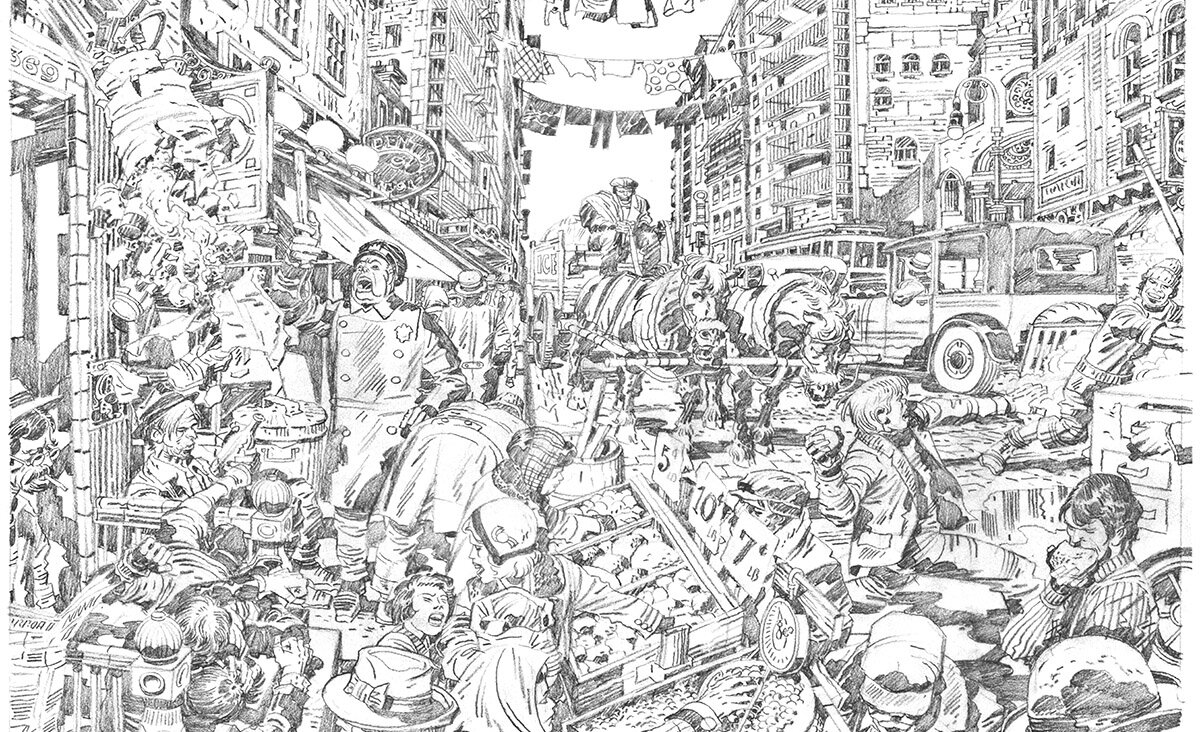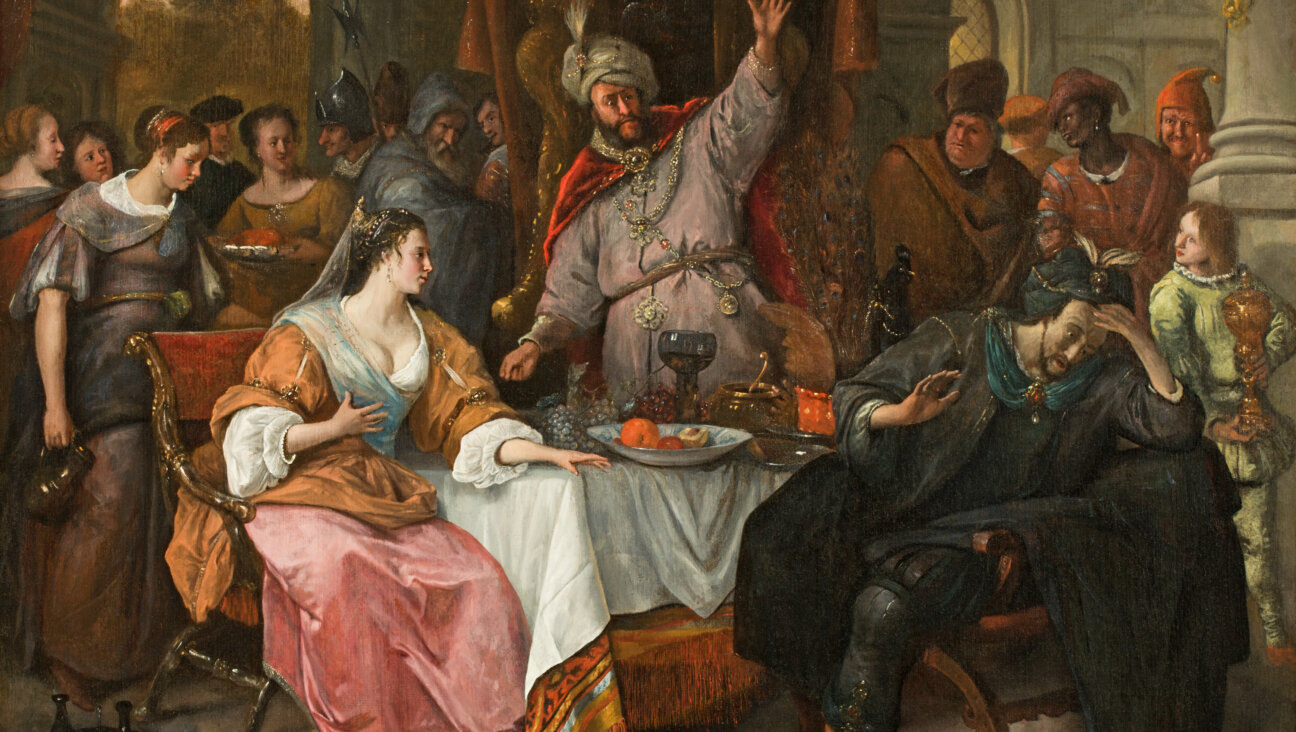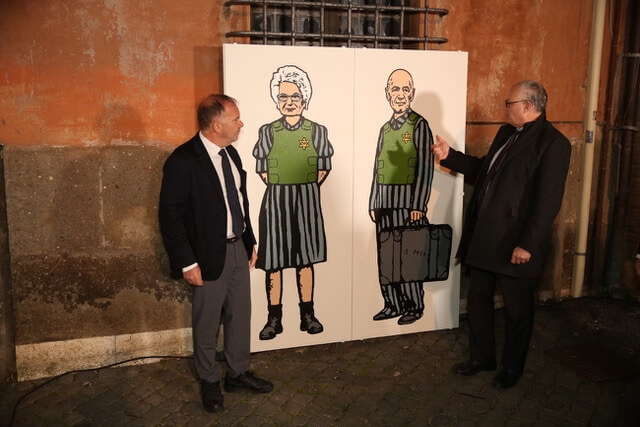The Exhilarating Passions of Marc Chagall

Image by Courtesy ShiM-Film Pictures
“Chagall-Malevich” is an exhilarating paean to the uplifting power of art.
Part docu-drama, part fantasy, the film is largely based on the life of Marc Chagall, widely considered the greatest Jewish artist of the 20th Century.
Born Moishe Shagal into a Hasidic community in the Pale of the Settlement, Chagall found and pursued his passion early in life. He attended art school in St. Petersburg and then moved to Paris. There, after additional study, he found considerable success, before returning to his home in Vitebsk and to his fiancée, Bella Rosenfeld.
On his return, Chagall (played by Leonid Bichevin) weds Bella (Kristina Schneidermann). Fortunately, a childhood friend of both bride and groom, Naum (Semyon Shkalikov), is the local Red Army commissar. Though a slightly bitter failed suitor of Bella, he arranges for Marc to found the Vitebsk Arts College.
It did not happened in the manner depicted here. Chagall was one of the country’s most distinguished artists and didn’t need a local commissar to find him a position. Nevertheless, there’s universal agreement that his fervor attracted some of the most highly regarded artists as professors.
Chagall, himself, was open to all styles of art — though that later would cause him difficulty when a rival, Kazimir Malevich (Anatoliy Belyy), found favor with the authorities.
Though his supporters felt Malevich was undermining Chagall, and urged their master to get rid of him, Chagall refused. He had no time or temperament for politics; all he cared about was art.
Ultimately, Chagall and his family were forced to flee Vitebsk; I won’t spoil the totally satisfying denouement by revealing how they make their art-related escape. But it is pitch perfect.
I’m a sucker for films about artists and their passions. I enjoyed “Pollock,” Ed Harris’s reasonably straightforward biopic about splatter artist Jackson Pollock. But I adored “American Splendor” (about graphic artist Harvey Peckar) and “Frieda” (about Frieda Kahlo). Both used the artists’ paintings and drawings as virtual characters, helping infuse the films with a greater sense of their spirit and fervor.
And so it with “Chagall-Malevich,” which director Alexander Mitta injects with surrealistic imagery that invokes Chagall’s phantasmagorical works and his almost addictive compulsion to produce art.
Mitta also sensitively recreates the Hasidic world of the Pale in the years immediately before and after the Russian Revolution.
Not that I don’t have a nit to pick. The film is in Russian with English subtitles. Balancing between watching the actors and reading is a circus act under the best of circumstances. Here, though, it’s more difficult than normal because too often the words blend into the background visuals, making them unintelligible.
Still, “Chagall-Malevich” is inspiring and well worth the effort.
The Forward is free to read, but it isn’t free to produce

I hope you appreciated this article. Before you go, I’d like to ask you to please support the Forward.
Now more than ever, American Jews need independent news they can trust, with reporting driven by truth, not ideology. We serve you, not any ideological agenda.
At a time when other newsrooms are closing or cutting back, the Forward has removed its paywall and invested additional resources to report on the ground from Israel and around the U.S. on the impact of the war, rising antisemitism and polarized discourse.
This is a great time to support independent Jewish journalism you rely on. Make a gift today!
— Rachel Fishman Feddersen, Publisher and CEO
Support our mission to tell the Jewish story fully and fairly.
Most Popular
- 1

Culture Cardinals are Catholic, not Jewish — so why do they all wear yarmulkes?
- 2

Fast Forward Ye debuts ‘Heil Hitler’ music video that includes a sample of a Hitler speech
- 3

News School Israel trip turns ‘terrifying’ for LA students attacked by Israeli teens
- 4

Fast Forward Student suspended for ‘F— the Jews’ video defends himself on antisemitic podcast
In Case You Missed It
-

Yiddish קאָנצערט לכּבֿוד דעם ייִדישן שרײַבער און רעדאַקטאָר באָריס סאַנדלערConcert honoring Yiddish writer and editor Boris Sandler
דער בעל־שׂימחה האָט יאָרן לאַנג געדינט ווי דער רעדאַקטאָר פֿונעם ייִדישן פֿאָרווערטס.
-

Fast Forward Trump’s new pick for surgeon general blames the Nazis for pesticides on our food
-

Fast Forward Jewish feud over Trump escalates with open letter in The New York Times
-

Fast Forward First American pope, Leo XIV, studied under a leader in Jewish-Catholic relations
-
Shop the Forward Store
100% of profits support our journalism
Republish This Story
Please read before republishing
We’re happy to make this story available to republish for free, unless it originated with JTA, Haaretz or another publication (as indicated on the article) and as long as you follow our guidelines.
You must comply with the following:
- Credit the Forward
- Retain our pixel
- Preserve our canonical link in Google search
- Add a noindex tag in Google search
See our full guidelines for more information, and this guide for detail about canonical URLs.
To republish, copy the HTML by clicking on the yellow button to the right; it includes our tracking pixel, all paragraph styles and hyperlinks, the author byline and credit to the Forward. It does not include images; to avoid copyright violations, you must add them manually, following our guidelines. Please email us at [email protected], subject line “republish,” with any questions or to let us know what stories you’re picking up.















